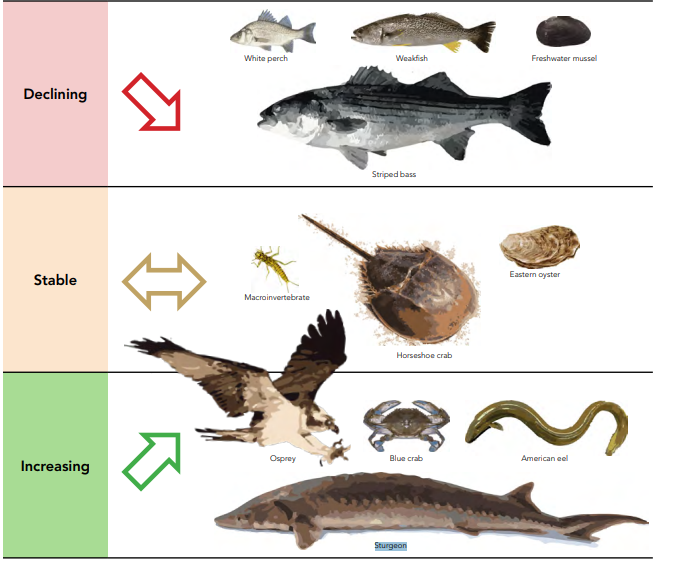
Report gives Delaware Estuary and Basin a ‘fair’ health rating
Editor’s note: For Earth Day, Delaware Currents is reporting on the 2022 TREB, a 400-plus-page technical assessment of the health of the Delaware Estuary and Basin.
| April 22, 2023
The health of the Delaware Estuary and Basin remains unchanged since 2008, earning a “fair” rating based on a blend of worsening and improving trends, according to a report that assessed more than 50 environmental indicators.
The findings in the document, the “Technical Report for the Delaware Estuary and Basin,” were decidedly mixed.
It showed gains in measures of water quality, such as dissolved oxygen, which is vital for aquatic life, and increasing efforts to preserved land from construction. At the same time, it documented a decline in forested areas as development continues, and sounded an alarm about the effects of climate change.
The 445-page report, a product of the Partnership for the Delaware Estuary and the Delaware Estuary Program, draws on the work of dozens of researchers, government agencies and nonprofits. It offers a snapshot of the health of a region that is the source of drinking water to millions of people, a vital habitat to fish and wildlife as well as an outlet for recreational users.
The report, which was released in December, notes that the overall grade of “fair” is unchanged from previous assessments dating back to 2017 and 2012 and a smaller “State of the Estuary Report” from 2008.
Reflecting its good news/bad news content, the report offered a measure of celebration and a warning: “The ‘fair’ rating “reflects substantial improvement compared to earlier decades for many key indicators,” it said.
Read more: A ‘sobering’ look at the effects of climate change on the Delaware Estuary
On the bad news front, the report added: “Unfortunately, the continued loss and degradation of important habitats and emerging threats associated with climate change could or may undermine the recent recovery. Meanwhile, the human population in the watershed continues to increase, resulting in expanding human activities (which) are likely to increasingly tax our natural resources and require management diligence, especially with regard to water withdrawals, forest cutting, wetland loss and development.”

Report card at a glance
Viewed as a report card, the TREB awarded high honors to some categories for their improvements and handed out demerits to others for their poor showings.
The report assigned scores of one to six – with one being very good and six being detrimental – to different indicators and conditions.
On the plus side: Concentrations of dissolved oxygen have increased dramatically from the 1960s; dams have been removed in the Delaware River Basin to improve the mobility of fish and the populations of the osprey, blue crab and American eel have increased.
There were an equal number of negative conditions, however.
Earning a score of six: development increased by about 17.5 acres per day from 1996-2016, bringing with it a growing amount of impervious surfaces; sediment contaminants are highest in areas of the estuary near environmental justice communities, and many fish consumption advisories remain in place.
Aquatic life highlights
The report struck a hopeful note about the status of the endangered Atlantic sturgeon, which over the decades has struggled with fluctuating environmental conditions, boat strikes and, perhaps most notably, dissolved oxygen levels that were too low to support propagation.
Still, the TREB found that the Atlantic sturgeon are reproducing “in most years in current conditions in the river,” with hundreds to thousands of sturgeons up to a year old to be found.
That means the Delaware Bay is able to support more consistent levels of subadults and adults than during the previous decade, the report found.

Warnings about the effects of climate change
The report described an estuary and basin that would be affected by climate change, with more 90-degree-plus days, increasing and intensifying precipitation and rising sea levels.
Climbing air temperatures, declining frost days — days per year below 32 degrees that have recorded a “significant decrease” over the past 112 years — and rising sea levels are all trends that are not only increasing but also accelerating, the report said.
Fitting this overall pattern, indications point to lower amounts of snow and ice and fewer cases of ice jams, the report found.
More intense storms will exacerbate flooding, the report said, adding, “With a projected additional increase in sea level of over 1 meter along the Delaware River, tropical and cool-season storms will become more damaging and far reaching.”







